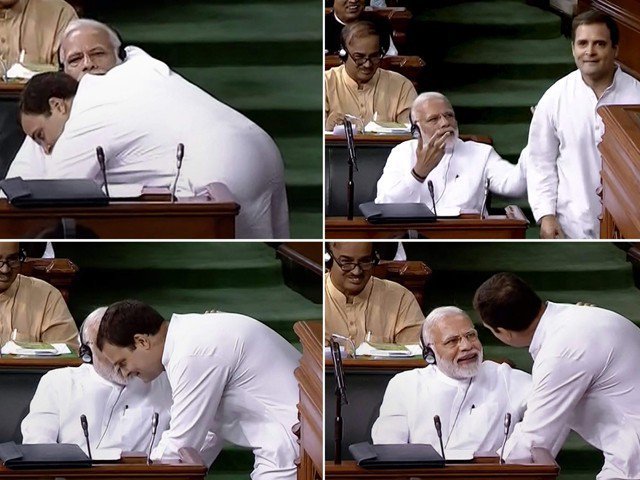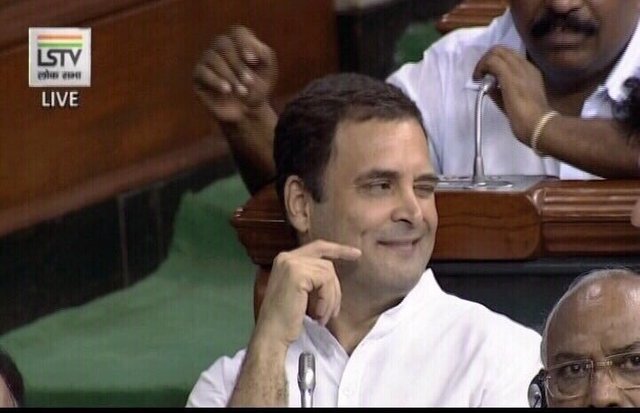Rahul Gandhi pulled a Modi, but what does it signify?

The Indian parliament witnessed an unusual scene that has become the talking point of the recent no-confidence motion initiated by the opposition against the Narendra Modi government. On Friday, after making his speech against the government, Rahul Gandhi surprised all – especially Modi himself – by going across the aisle and hugging him.
Modi was visibly caught off guard, but recovered quickly and shook hands with Rahul. The gesture drew censure from the speaker of the house, and yet it represented a bipartisanship that has been eroding for some time now from the Indian political landscape.
Watch video :- https://twitter.com/ANI/status/1020236522736345094
Bipartisanship has been eroding because this is not the Bharatiya Janata Party (BJP) of Atal Bihari Vajpayee. The BJP under the Nehru-admiring Vajpayee had attempted to put Hindutva on the backburner (after using it adroitly to come to power) and had sought to use a more conciliatory approach in dealing with issues. Vajpayee’s loss in the 2004 General Elections was seen as the failure of this approach by the right-wing in India.
Putting Hindutva on the backburner was a mistake, they surmised. Upon clinching power again after 10 years of United Progressive Alliance (UPA) rule, they have been intent on making sure they do not repeat that apparent mistake. Far from being pushed to the backburner, Hindutva is now the overt leitmotif of the Modi government; one that enables lynch mobs to indulge in acts of terror in the name of Hindutva without compunction, and one that sees Union ministers with moderate histories coming to their support to earn brownie-points with their bosses.
It has engendered McCarthyism in Indian politics, where criticism of the government has been attacked as anti-nationalist in order to inure both the government and its ideology from questions. In this backdrop, with the rising tide of Hindutva widening the aisle separating people’s differences, Rahul’s “walk across the aisle” hug caught everyone off guard.
And yet something about the hug from Rahul seemed fitting of the kind of politics he talks about practicing. The hug was the culmination of a significantly improved performance by Rahul in the Lok Sabha. His record in the Lok Sabha is otherwise rather pedestrian, but he seemed to come alive on Friday. There was an aggression in his delivery that was almost refreshing, coming from the leader of an enfeebled and brow-beaten opposition; one that does not even have the status of ‘leader of the opposition’.
He listed the ‘jumlas’ (false promises) that the Modi government had delivered for years to a sometimes-naive public yearning for improvements, and made the point that the government had failed in delivering on most of its major promises. He levelled serious charges of graft against the government and left the BJP – including the Defence Minister herself – seething. And yet he chose as his crescendo a hug, suggesting that the aggression is a tool but it does not change his approach to politics; one that speaks of a politics that doesn’t emerge from hate, but is grounded in compassion.

Beyond the cynicism, however, the hug symbolises something very important: Rahul taking a different approach than his mother’s in dealing with Modi. Sonia Gandhi once famously referred to Modi as ‘maut ka saudagar’, a pariah who had no place in Indian politics. However, Rahul is clearly not taking that line, for that rhetoric has not worked. Sonia had used it during the 2007 Gujarat Assembly Elections, and the Congress lost that election. Similar rhetoric did not work in the 2014 Elections either.
Rahul’s approach seems to be to try and come across as more large-hearted, to undermine some of the polarisation the BJP engenders by toning down the rhetoric and reaching across the aisle to his opponents and the swing vote.